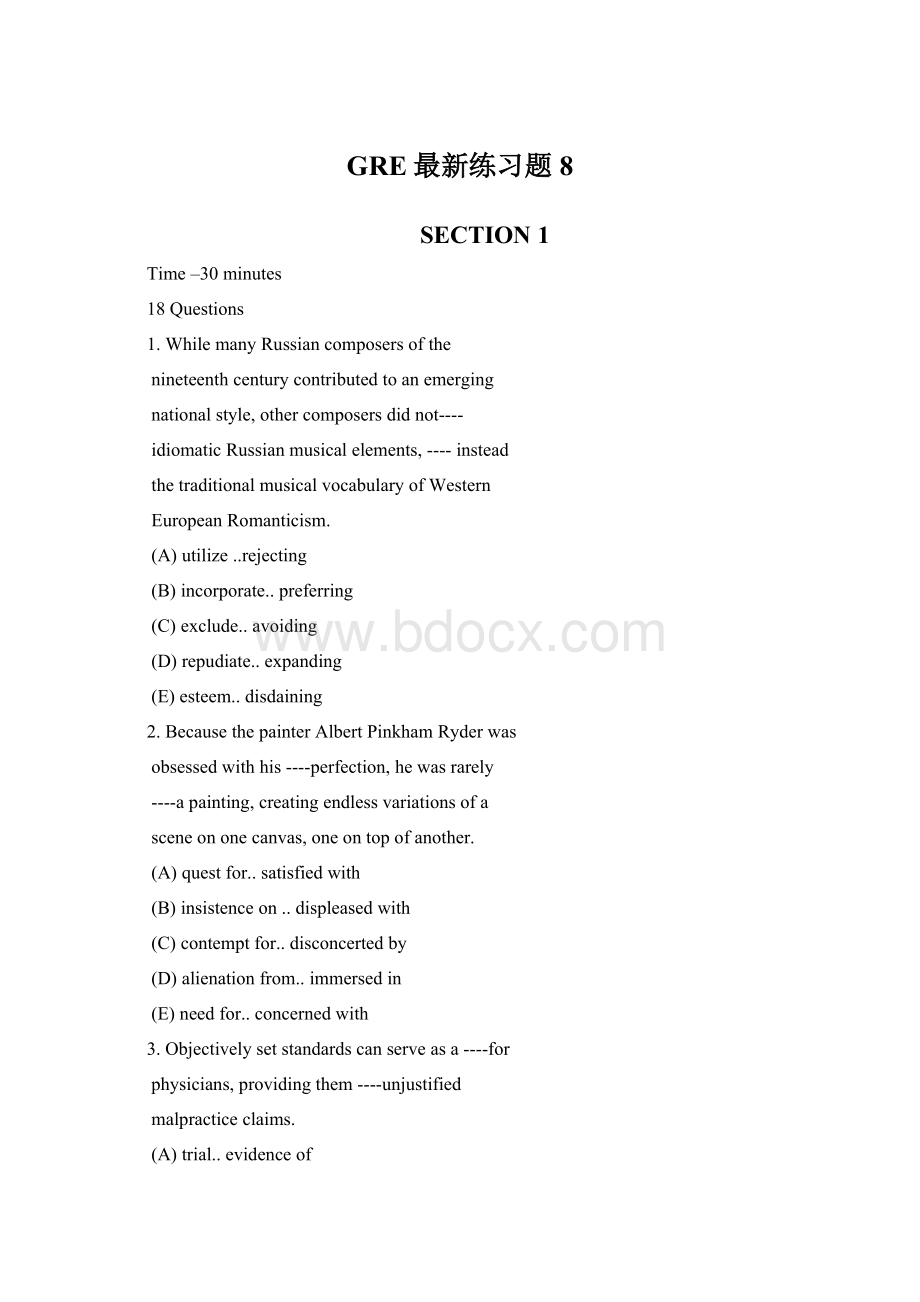GRE最新练习题8.docx
《GRE最新练习题8.docx》由会员分享,可在线阅读,更多相关《GRE最新练习题8.docx(66页珍藏版)》请在冰豆网上搜索。

GRE最新练习题8
SECTION1
Time–30minutes
18Questions
1.WhilemanyRussiancomposersofthe
nineteenthcenturycontributedtoanemerging
nationalstyle,othercomposersdidnot----
idiomaticRussianmusicalelements,----instead
thetraditionalmusicalvocabularyofWestern
EuropeanRomanticism.
(A)utilize..rejecting
(B)incorporate..preferring
(C)exclude..avoiding
(D)repudiate..expanding
(E)esteem..disdaining
2.BecausethepainterAlbertPinkhamRyderwas
obsessedwithhis----perfection,hewasrarely
----apainting,creatingendlessvariationsofa
sceneononecanvas,oneontopofanother.
(A)questfor..satisfiedwith
(B)insistenceon..displeasedwith
(C)contemptfor..disconcertedby
(D)alienationfrom..immersedin
(E)needfor..concernedwith
3.Objectivelysetstandardscanserveasa----for
physicians,providingthem----unjustified
malpracticeclaims.
(A)trial..evidenceof
(B)model..experiencewith
(C)criterion..reasonsfor
(D)test..questionsabout
(E)safeguard..protectionfrom
4.Inspiteof----reviewsinthepress,the
productionofherplaywas----almostcertain
oblivionbyenthusiasticaudienceswhose
acumenwasgreaterthanthatofthecritics.
(A)lukewarm..condemnedto
(B)scathing..exposedto
(C)lackluster..rescuedfrom
(D)sensitive..reducedto
(E)admiring..insuredagainst
5.Thepassionsofloveandprideareoftenfound
inthesameindividual,buthavinglittlein
common,theymutually----,nottosaydestroy,
eachother.
(A)reinforce
(B)annihilate
(C)enhance
(D)weaken
(E)embrace
6.Thenecessityofestablishingdiscretecategories
forobservationsfrequentlyleadstoattemptsto
makeabsolute----whenthereareinreality
only----.
(A)analyses..hypotheses
(B)correlations..digressions
(C)distinctions..gradations
(D)complications..ambiguities
(E)conjectures..approximations
7.AuniqueclaydiskfoundattheMinoansiteof
Phaistosisoften----astheearliestexampleof
printingbyscholarswhohavedefendeditsclaim
tothisstatusdespiteequivalentclaimsput
forwardforotherprintingartifacts.
(A)questioned
(B)overlooked
(C)adduced
(D)conceded
(E)dismissed
8.EXEMPT:
LIABILITY:
:
(A)flout:
authority
(B)bestow:
reward
(C)permit:
request
(D)restrain:
disorder
(E)pardon:
penalty
9.FULL-BODIED:
FLAVOR:
:
(A)penetrating:
vision
(B)humorous:
character
(C)salacious:
language
(D)nostalgic:
feeling
(E)resonant:
sound
10.LEGACY:
PREDECESSOR:
:
(A)gift:
donor
(B)gratuity:
service
(C)contribution:
charity
(D)receipt:
customer
(E)loan:
collector
11.HERO:
ADMIRABLE:
:
(A)critic:
capricious
(B)braggart:
surly
(C)eccentric:
unconventional
(D)anarchist:
powerful
(E)enemy:
immoral
12.GALVANIZE:
STIMULATE:
:
(A)agitate:
occlude
(B)incubate:
humidify
(C)sterilize:
separate
(D)irrigate:
flush
(E)purify:
amalgamate
13.MANIFEST:
PERCEIVE:
:
(A)porous:
tear
(B)renovated:
improve
(C)doubtful:
assess
(D)brittle:
break
(E)elite:
qualify
14.LOOSE:
CONFINEMENT:
:
(A)forgive:
injury
(B)promulgate:
rule
(C)disabuse:
misconception
(D)redress:
allegation
(E)disengage:
independence
15.BLANDISHMENT:
COAX:
:
(A)prevarication:
deceive
(B)reverie:
dream
(C)persuasion:
coerce
(D)enticement:
impoverish
(E)explanation:
mislead
16.CONVULSION:
CONTRACTION:
:
(A)aggression:
attack
(B)sulkiness:
punishment
(C)persistence:
acquiescence
(D)frenzy:
emotion
(E)indifference:
greeting
Muchoftheresearchonhallucinogenicdrugssuch
asLSDhasfocusedontheneurotransmitterserotonin,
achemicalthatwhenreleasedfromapresynaptic
serotonin-secretingneuroncausesthetransmissionof
(5)anerveimpulseacrossasynapsetoanadjacent
postsynaptic,ortarget,neuron.Therearetwomajor
reasonsforthisemphasis.First,itwasdiscovered
earlyonthatmanyofthemajorhallucinogenshavea
molecularstructuresimilartothatofserotonin.In
(10)addition,animalstudiesofbrainneurochemistry
followingadministrationofhallucinogensinvariably
reportedchangesinserotoninlevels.
Earlyinvestigatorscorrectlyreasonedthatthe
structuralsimilaritytotheserotoninmoleculemight
(15)implythatLSD’seffectsarebroughtaboutbyan
actionontheneurotransmissionofserotonininthe
brain.Unfortunately,theleveloftechnicalexpertise
inthefieldofbrainresearchwassuchthatthis
hypothesishadtobetestedonperipheraltissue
(20)(tissueoutsidethebrain).Twodifferentgroupsof
scientistsreportedthatLSDpowerfullyblockaded
serotonin’saction.Theirconclusionswerequickly
challenged,however.Wenowknowthattheaction
ofadrugatonesiteinthebodydoesnotnecessarily
(25)correspondtothedrug’sactionatanothersite,
especiallywhenonesiteisinthebrainandtheother
isnot.
Bythe1960’s,technicaladvancespermittedthe
directtestingofthehypothesisthatLSDandrelated
(30)hallucinogensactbydirectlysuppressingtheactivity
ofserotonin-secretingneuronsthemselves—theso-
calledpresynaptichypothesis.Researchersreasoned
thatifthehllucinogenicdrugsactbysuppressingthe
activityofserotonin-secretingneurons,thendrugs
(35)administeredaftertheseneuronshadbeendestroyed
shouldhavenoeffectonbehavior,becausethe
systemwouldalreadybemaximallysuppressed.
Contrarytotheirexpectations,neurondestruction
enhancedtheeffectofLSDandrelatedhallucinogens
(40)onbehavior.Thus,hallucinogenicdrugsapparently
donotactdirectlyonserotonin-secretingneurons.
However,theseandotheravailabledatadosupport
analternativehypothesis,thatLSDandrelateddrugs
actdirectlyatreceptorsitesonserotonintarget
(45)neurons(thepostsynaptichypothesis).Thefactthat
LSDelicits“serotoninsyndrome”—thatis,causes
thesamekindsofbehaviorsasdoestheadminis-
trationofserotonin—inanimalswhosebrainsare
depletedofserotoninindicatesthatLSDactsdirectly
(50)onserotoninreceptors,ratherthanindirectlythrough
thereleaseofstoresofserotonin.Theenhancedeffect
ofLSDreportedafterserotonindepletioncouldbe
duetoaproliferationofserotoninreceptorsiteson
serotonintargetneurons.Thisphenomenonoften
(55)followsneurondestructionorneurotransmitter
depletion;theincreaseinthenumberofreceptorsites
appearstobeacompensatoryresponsetodecreased
input.Significantly,thishypothesisissupportedby
datafromanumberofdifferentlaboratories.
17.Accordingtothepassage,whichofthe
followingisoneoftheprimaryfactorsthatled
researchersstudyinghallucinogenicdrugsto
focusonserotonin?
(A)Thesuppressionoftheactivityofserotonin-
secretingneuronsbytheadministrationof
hallucinogens
(B)Theobservedsimilaritiesinthechemical
structuresofserotoninandhallucinogens
(C)Theeffectstheadministrationof
hallucinogenshasonserotoninproduction
inthehumanbrain
(D)Serotonin-inducedchangesintheeffectsof
hallucinogensonbehavior
(E)Hallucinogen-inducedchangesintheeffects
ofserotoninonbehavior
18.Itcanbeinferredthatresearchersabandonedthe
presynaptichypothesisbecause
(A)anewandmoreattractivehypothesiswas
suggested
(B)noresearchwasreportedthatsupportedthe
hypothesis
(C)researchresultsprovidedevidenceto
counterthehypothesis
(D)thehypothesiswassupportedonlyby
studiesofanimalsandnotbystudiesof
humanbeings
(E)theleveloftechnicalexpertiseinthefieldof
brainresearchdidnotpermitadequate
testingofthehypothesis
19.Whichofthefollowingbestexpressesthemain
ideaofthepassage?
(A)Researchhassuggestedthatthe
neurotransmitterserotoninisresponsiblefor
theeffectsofhallucinogenicdrogsonthe
brainandonbehavior.
(B)Researchershavespentaninadequateamount
oftimedevelopingtheoriesconcerningtheway
inwhichtheeffectsofhallucinogenicdrugsoccur.
(C)Researchresultsstronglysuggestthat
hallucinogenicdrugscreatetheireffectsby
actingontheserotoninreceptorsiteslocated
ontargetneuronsinthebrain.
(D)Researchershaverecentlymadevaluable
discoveriesconcerningtheeffectsof
depletingtheamountofserotonininthe
brain.
(E)Researchershaveconcludedthathallucinogenic
drugssuppresstheactivityofserotonin-secreting
neurons.
20.Theresearchdescribedinthepassageis
primarilyconcernedwithansweringwhichof
thefollowingquestions?
(A)Howcanresearcherscontroltheeffectsthat
LSDhasonbehavior?
(B)Howareanimals’reactionstoLSDdifferent
fromthoseofhumanbeings?
(C)WhattriggerstheeffectsthatLSDhason
humanbehavior?
(D)Whattechnicaladvanceswouldpermit
researcherstopredictmoreaccuratelythe
effectsofLSDonbehavior?
(E)Whatrelationshipdoesthesuppressionof
neuronactivityhavetotheoccurrenceof
“serotoninsyndrome”?
21.Whichofthefollowingbestdefines“serotonin
syndrome”(line46)asthetermisusedinthe
passage?
(A)Theseriesofbehaviors,usuallyassociated
withtheadministrationofserotonin,thatalso
occurswhenLSDisadministeredtoanimals
whosebrainsaredepletedofserotonin
(B)Theseriesofbehaviors,usuallyassociated
withtheadministrationofLSD,thatalso
occurswhentheamountofserotonininthe
brainisreduced
(C)Themaximalsuppressionofneuronactivity
thatresultsfromthedestructionofserotonin-
secretingneurons
(D)Thereleaseofstores